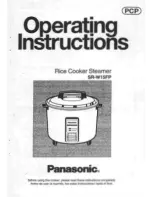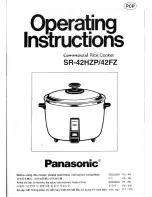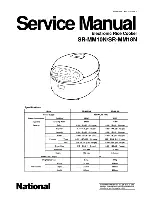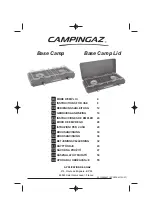
Tested for you in our cooking studio
en
45
dependent on the type, moisture, ripeness and
thickness of the food. The longer you leave the food to
be dried, the better it will be preserved. The more thinly
you slice the food, the more quickly it will dry and the
more flavour it will retain.For this reason, the table
specifies setting ranges.
If you wish to dry food that is not listed in the table, you
should use the settings listed in the table for similar
food as reference.
Preserving
For preserving, the jars and rubber seals must be clean
and intact. If possible, use jars of the same size. The
information in the table is for round, one-litre jars.
Caution!
Do not use jars that are larger or taller than this. The
lids could crack.
Only use fruit and vegetables in good condition. Wash
them thoroughly.
The times given in the tables are a guide only. The time
will depend on the room temperature, number of jars,
and the quantity and temperature of the contents.
Before you switch off the appliance or change the
cooking mode, check whether the contents of the jars
are bubbling as they should.
Preparation
1.
Fill the jars, but not to the top.
2.
Wipe the rims of the jars, as they must be clean.
3.
Place a damp rubber seal and a lid on each jar.
4.
Seal the jars with the clips.
Place no more than six jars in the cooking
compartment.
Settings
1.
Insert the universal pan at level 2. Arrange the
preserving jars so that they do not touch each other.
2.
Pour ½ litre of water (approx. 80 °C) into the
universal pan.
3.
Close the oven door.
4.
Set Bottom heat
$
.
5.
Set the temperature to 170 - 180 °C.
Preserving
Fruit
After approx. 40 to 50 minutes, small bubbles begin to
form at short intervals. Switch off the oven.
After 25 to 35 minutes of residual heat, remove the
preserving jars from the cooking compartment. If they
are allowed to cool for longer in the cooking
compartment, germs could multiply, promoting
acidification of the preserved fruit.
Vegetables
As soon as bubbles begin to form in the jars, set the
temperature back to between 120 and 140 °C.
Depending on the type of vegetable, heat for approx. 35
to 70 minutes. Switch off the oven after this time and
use the residual heat.
Taking out the jars
After preserving, remove the jars from the cooking
compartment.
Caution!
Do not place the hot jars on a cold or wet surface. They
could suddenly burst.
Fruit, vegetables and herbs
Accessories
Heating
function
Temperature in
°C
Cooking time in
hours
Pomes (apple rings, 3 mm thick, 200 g per wire rack)
1-2 wire racks
<
80
4-8
Root vegetables (carrots), grated, blanched
1-2 wire racks
<
80
4-7
Sliced mushrooms
1-2 wire racks
<
80
5-8
Herbs, washed
1-2 wire racks
<
60
2-5
Fruit in one-litre jars
When it starts to bubble
Residual heat
Apples, redcurrants, strawberries
Switch off
approx. 25 minutes
Cherries, apricots, peaches, gooseberries
Switch off
approx. 30 minutes
Apple purée, pears, plums
Switch off
approx. 35 minutes
Vegetables with cold cooking water in one-litre jars
When it starts to bubble
Residual heat
Gherkins
-
approx. 35 minutes
Beetroot
approx. 35 minutes
approx. 30 minutes
Brussels sprouts
approx. 45 minutes
approx. 30 minutes
Beans, kohlrabi, red cabbage
approx. 60 minutes
approx. 30 minutes
Peas
approx. 70 minutes
approx. 30 minutes
Содержание HXS59II51N
Страница 2: ......




































